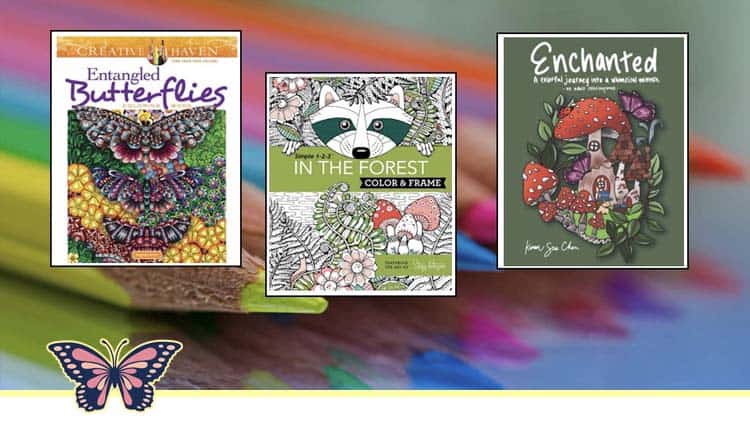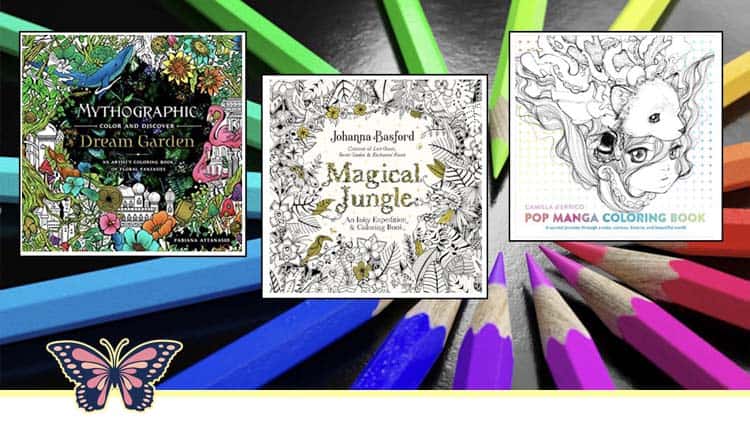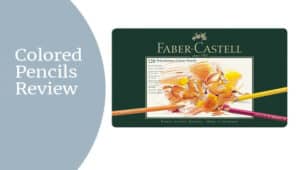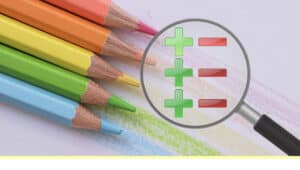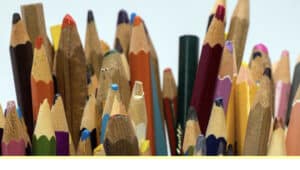
A detailed guide providing about how to evaluate and buy a coloring book.
Adult coloring is among the most satisfying pastimes I have ever experienced. All it takes is your favorite coloring pencils, coloring book, comfortable chair, or favorite place for the day. Coloring happens at home when traveling, at the park, or in your neighborhood coffee shop. When we are coloring, we spend many hours searching for, selecting, buying, and coloring in a coloring book.
This article is very detailed. I am going to share a variety of ways in which to review and evaluate coloring books. I have written the article so that you quickly review what is most important to you. I will cover the following:
- Deciding What to Color
- Introduction to Choosing a Coloring Book
- How to Evaluate Amazon Coloring Book Reviews
- Using Amazon Search Parameters
- Lessons Learned from Coloring Book Purchase
How to Buy A Coloring Book Guide
Table of Contents
-
- Deciding What to Color
- What Would I Like to Color?
- Deciding What to Color Lessons Learned
- Introduction to Choosing A Coloring Book
- Coloring Book Level of Detail
- Consistent Theme and Quality
- Format Dimensions for Coloring Books
- Coloring Book Layout and Design
- Single-sided vs. Double-sided Printing
- Coloring Book Paper Quality
- Coloring Book Paper Thickness
- Coloring Book Binding
- Coloring Book “Gutter” Margins
- Coloring Book Perforated Pages
- Coloring Book Consistent Page Orientation
- Coloring Book Price
- Authors Schreiber’s Coloring Book Decision Criteria
- How to Evaluate Amazon Coloring Book Reviews
- Using Amazon Search Parameters
- Lesson Learned from Coloring Book Purchase
Other resources. Check out other supporting resources on ColoringButterfly.com that you might enjoy.
- Buying Colored Pencils? Everything You Need Know (Guide)
- 11 Ways to Spot Fake Coloring Books on Amazon (Checklist)
- How to (Really) Enjoy Copyrighted Coloring Books
- 9 Ways to Spot A Safe vs. Shady Amazon Third-party Seller
- Inkjet vs. Laser Printers: (Detailed) Guide for Adult Coloring
- Adult Coloring Book Paper: Can It Make A Difference? (See How)
Deciding What to Color
Adult coloring books can feature artwork/illustrations that are simplistic to very intricate details. Adult coloring books are different than those intended for younger audiences, and the coloring books have a level of complexity that invites you to become immersed in the coloring experience.
When I first began my journey in coloring, I was amazed at all the types of coloring books available. They ranged in topic from Jungle Animals to Gardens and from Mandalas to Dragons. I started with a Mandala Coloring Book from ColorIt and began learning about coloring combinations, layering, blending, and more from the choice. From the first coloring book, I began to navigate the world of coloring books, themes and more. [TOC]
What Would I Like to Color?
Deciding on what to color can be fun and frustrating at the same time because there are so many choices. Where to begin? This was my experience in making that decision. For my next coloring book choice, I focused on what I liked. I made a list that included flowers, gardens, dragons, and mornings.
I began with a Google search of “Garden Coloring Books.” Within a few clicks, I found my way to Amazon. That’s when the confusion began. I couldn’t believe there were so many coloring books about gardens. I must have looked at 20 coloring books. I read reviews, watched the coloring book flip through, read more reviews, and pressed the purchase button.
I choose a book by Johanna Basford, Secret Garden. I have loved my time spent coloring in that book. I have enjoyed learning new skills and finding new resources like YouTube coloring along and how-to coloring videos. I have enjoyed the peace as I experience the pages come alive with color. [TOC]
Deciding What to Color Lessons Learned
That experience helped me learn several important lessons.
- The adult coloring community is vibrant and helpful. In the world of coloring, there is a vibrant, active community of adult coloring who share their experiences, skills, and joy of coloring. Their reviews helped guide me in narrowing my choices and what I wanted to color.
- Start with a prominent category/theme and narrow your focus. You can start by listing what you like and begin your search. What I found to be most straightforward is to start with an online search for a significant category/theme and narrow my search. I will start with themes like patterns, intricate designs, garden scenes, animals, fantasy, and sci-fi. As I look at the at is returned, I will browse the top 10-20 coloring books in the return, watch coloring book flip-throughs, read reviews and ponder. This exercise gives me an idea of what is available, who the authors/artists are, the complexity/simplicity of the illustrations/art and what sparks my interest.
- You are continually growing in adult coloring. As you expand your skills and experience coloring, you will learn what themes and topics you like to color, the authors/artists you enjoy, and the features you like in coloring books (e.g., paper, single-sided, perforated.
- There is always one more coloring book. As you color, your find new themes, new authors/artists, and coloring adventures. Enjoy the experience. [TOC]
Introduction to Choosing A Coloring Book

The remarkable aspect of coloring is you are in control of what you like and what is important to you in colored pencils, coloring books, and supplies. In this article section, I would like to provide an in-depth look at all the essential elements to consider when purchasing your coloring books. These coloring book attributes will/can make a huge difference in your coloring adventure. [TOC]
Coloring Book Level of Detail
Adult coloring books can feature artwork/illustrations with simplistic to very intricate details. Adult coloring books are different than those intended for younger audiences. The coloring books have complexity, which invites you to become immersed in the coloring experience. You can match the coloring book to your skill level and interests (e.g., themes, subject matter). For example, if you are a beginner and not interested in detail, you may want to look for coloring book illustrations/designs that have less dense/larger designs. If your skills are a little more advanced and you what a challenge, you may choose coloring books’ with intricate scenes or patterns. [TOC]
Consistent Theme and Quality for Artwork/Illustrations
Successful coloring books have a central theme, such as flowers, butterflies, landmarks, holidays, and Celtic designs. Ensure the artwork/illustrations follow the same theme and are not a compilation of random, unrelated drawings.
When buying a coloring book, you expect the artwork/illustrations to be high quality. The line art must
- Appear smooth and uniform
- Have good contrast and high resolution
- Have no line inconsistencies (some lines are dense and thick, others are thin).
- Have careful, consistent formatting ( e.g., self-published coloring books often have a problem where the images appear distorted or out of proportion). [TOC]
Format Dimensions for Coloring Books
Coloring books come in a variety of formats and dimensions. The dimensions refer to the width and height of the coloring surface in its finished form. For example, some of the coloring formats I own are as follows:
- Postcards (e.g., 5 x 7 inches; 12.7 x 17.78 cm)
- Pocket-/travel-sized coloring books (e.g., 6.4 x 6.4 Inches; 16.51 x 16.41)
- Standard coloring book (e.g., 8.5×11 Inches; 21.59 x 27.94 cm
- Square format coloring books (e.g., 9.97 x 9.94 inches; 25.1 x 25.3 cm)
- Jumbo/artist editions (e.g, 9.88 x 13.13 inches; 25 x 33 cm)
When choosing coloring format/page size, think about questions like
- How detailed do you want the illustrations to be
- Do you want to finish coloring an illustration in one sitting
- Are you ok with returning to coloring the illustration over time
- How busy is your schedule
- Do you want a format you can put in your handbag
- What surface are you going to use for coloring
- How involved do you want to be in your coloring experience
- Will you be using colored pencils, makers, and gel pens [TOC]
Coloring Book Layout and Design
The coloring book layout and design are about the physical look and feel. Are the pages printed on one or both sides of the paper? How is the coloring book bound (e.g., spiral bound, stapled, glued)? Are the pages perforated for easy removal? Does the book lay flat when opened? Each of these design elements will affect your coloring experience. The coloring book design has a direct bearing on its price. Let’s take a look at some of the standard features that.. [TOC]
Single-sided vs. Double-sided Printing
Coloring books are printed on 1-side or 2-sides of paper.
Some of the benefits of one-sided printing on sheets within a coloring book are
- Limits artwork, see-through. It helps to keep any artwork from showing through to the other side of the sheet.
- Easier removal. If you remove a page from the coloring book to display it, there is no image on the reverse side to become wasted or go unused.
- Bleed through. Coloring with media like gel pens and markers is less or no bleed-through. [TOC]
Coloring Book Paper Quality
Paper is an essential factor in deciding the coloring experience’s outcome. For example, if you use Prismacolor Premier, a waxed-base colored pencil on paper that does not accept wax-based cores very well, the color can be muted. You will lose some of Prismacolor Premier’s unique coloring characteristics. The grade of paper in coloring books can range from printer’s (copy paper) to artists’ grade paper. Each grade of paper has a surface texture that has unique qualities and responds differently to coloring media (e.g., colored pencils, watercolor, gel pens, markers) and coloring technique/style.
Most coloring books use standard printing paper for their choice because of its mass availability, low cost, and general use. Because the pages of a coloring book are designed to be filled in, they are usually created from uncoated paper stock with enough surface (peaks and valleys). When buying a coloring book on Amazon or anywhere else, always check the info or the reviews to find out what kind of paper the designs are printed on and, most importantly, if they are single-sided or if a design is printed on both sides of the same page.
Also, the interior pages of a coloring book should be opaque so that the images do not readily show through from one side to the other. The importance of page thickness is usually dependent on the coloring tools /media you plan to use. For example, thicker pages will be better for preventing markers from bleeding through pages. [TOC]
Coloring Book Paper Thickness
The thickness of printing paper is usually referred to as its pound weight, which is designated as #…such as 70# or 100#. The higher the # number, the thicker the paper. If you want a quality coloring experience, consider acquiring a coloring book with a heavier grade of paper. In addition to having a much richer feel, a thicker paper will also help prevent any of your line art from showing through or your coloring medium (e.g., colored pencils, markers, gel pen) from bleeding to the other side. [TOC]
Coloring Book Binding
Coloring books are typically bound in one or more of the methods below. The binding can affect the number of pages in a coloring book if the page will lay flat or not when open,
- Saddle-stitched binding. In the staddle-stitch method, coloring books are folded sheets held together with wire staples inserted in the crease of the coloring books’ spine. With this method, you may need to continually hold the book in the open position while coloring.
- Perfect binding. Perfect-bound coloring books are created by gluing the pages and cover together at the spine with a strong, flexible glue. With this method, you may need to continually hold the book in the open position while coloring.
- Spiral bound binding. Spiral bound coloring books are spiral coil/wire-o binding. The binding allows the coloring book to open 360 degrees (cover to cover), and the feature allows the coloring book to lie perfectly flat in the open position. [TOC]
Coloring Book “Gutter” Margins
The gutter is the channel formed by the inner margins of two facing pages when the coloring book is opened. For example, when you open a coloring book, the illustration space is far enough from the binding so that you can color easily. One of my frustrations is finding a beautiful illustration to close the binding “gutter of the binding”; the line art gets buried too deep into the spinal crease and will be difficult to color. [TOC]
Coloring Book Perforated Pages
Perforated pages coloring books near the book’s spine (binding side) are an excellent and desired enhancement. Perforated pages can be associated with any binding style. Perforation allows each page to be easily detached from the rest of the book if you desire to
- Individually display once it has been colored
- Place the work surface (e.g., table, countertop) for coloring [TOC]
Coloring Book Consistent Page Orientation
Page orientation refers to the “direction” the illustrations/artwork face. Look to see if the coloring book images have a consistent orientation throughout the book. When you have a coloring book that mixes vertically-oriented designs with pages that contain horizontally-oriented designs, it can be unpleasant to rotate the coloring book back and forth. [TOC]
Coloring Book Price
The price of the coloring books depends on the design, type of illustrations, artist/author, and country/region of printing. The price you pay depends on your budget. Suppose you are new to coloring and not sure if you will want to start slowly by searching online for free adult coloring pages or a lower-cost coloring book. Most of my coloring books range from $5 to $15 USD, and I have some coloring books in my collection that exceed $25 USD (Yes, I did splurge).
Where do you get the best value? When I buy in brick-and-mortar stores (e.g., Hobby Lobby, Michaels), coloring books are usually at list price (sticker price) with no discounts. If I want to return a book, I need the receipt, and I have very restrictive return policies (e.g., 14 days, 15% restocking fee, in-store credit).
Online retailers have greater freedom. I can shop for coloring books around the world. I have purchased books from China, England/Europe, Canada, Japan and more. I personal like Amazon because of features like
- All coloring book/supply listings have extensive buyer information
- All shippers under the Amazon umbrella follow the same rules
- Huge volume and variety of coloring books
- All the supplies I need to color
- Extensive reviews from the coloring community
- Purchases are easy
- Shipping is free and fast with Prime (Usually Next Day)
- Returns are easy [TOC]
Authors Schreiber’s Coloring Book Decision Criteria
As I gained more experience, I began to explore new themes, formats, and artists/authors, making mental notes of what I liked in coloring books and creating a list that I use today when evaluating coloring books. The following is an overview of what is essential for me.
- The consistent theme in which all artwork/illustrations are related to the coloring books theme/topic.
- Medium to intricate artwork/illustrations.
- Formats of all types (e.g., postcards to jumbo artist editions).
- Single-sided printing avoids see-through and bleeding-through with markers/gel pens). I like putting a sheet of paper between the pages to capture the bleeds.
- Paper that is not bleeding when I want to use markers, gel pens.
- A spiral or binding will allow the artwork/illustrations to lay flat for easy coloring near the inner margins.
- Perforations along the inner page edge so individual pages can be removed for framing or coloring on a surface of choice.
- Heavyweight paper or even watercolor paper
- Crisp, sharp images appear smooth and uniform, have good contrast and high resolution and have no line inconsistencies (variation in line density).
- Wide gutters so artwork/illustrations do not get buried too deep into the spinal crease and will be difficult to color.
- High-quality colored pencils (I have a growing collection of pencil sets). [TOC]
How to Evaluate Amazon Coloring Book Reviews
Why do we read coloring book reviews? Reviews help us learn about the company and products before making a purchase. We read reviews because they
- Guide people who have used the product
- Make it easier for us to decide
- Testify a company’s reliability
- Reveal the best and worst that can occur
- Provide us insight into the product quality [TOC]
Tips for Reading Reviews
What are some of the tips for reading reviews? When reading the reviews, read a cross-section of 5-star to 1-star reviews. It’s surprising what you can learn even from the “worst” reviews. When reading reviews, check the date.
“Verified Purchase” reviewer. An “Amazon Verified Purchase” review means that Amazon verified that the person writing the review purchased or used the product on Amazon and didn’t receive the product at a significant discount. I place more weight on “Verified Purchases” than on those that are not, and I usually bypass them.
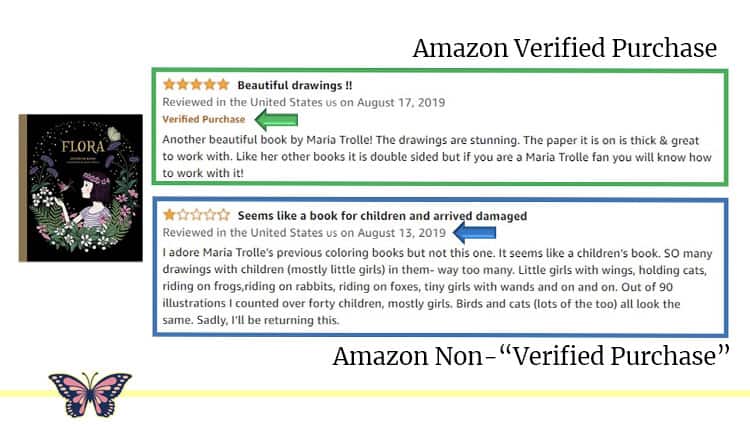
Example of Verified vs. Non-Verified Purchase from “Flora Coloring Book, by Maria Trolle.” By the way, I am a “Verified Purchase” of most of Maria Trolle’s coloring books.
Why do I bypass the Non-“Verified Purchase'” when it provides good information? Yes, the review can still provide a lot of good information. Still, in the back of my mind, I am asking whether the review is a fake review from friends, a paid review by the manufacturer, a review by a competitor, or the price other shoppers paid. I don’t know if the reviewer purchased the item on another site or a brick-and-mortar store (e.g., Hobby Lobby, Michaels). Not relying on non “Verified Purchase” is a conscious choice that allows me to feel more comfortable and safe with online purchasing decisions. [TOC]
When to Disregard “Verified Purchase” Reviewers
When do I disregard “Verified Purchase” reviewers? I have read hundreds of “Verified Purchase” reviews of all types of products on Amazon. There are a few common red flags that stand out to me. For example,
- Same review, just a different product. Suppose the reviewer is verbose and continues to say the same thing repeatedly. If I am suspicious about “Verified Reviewer,” I will click on the reviewer’s name and be able to see all the reviews the person has written. Does the reviewer give everybody 5-stars full of praise or 1-star reviews full of complaints? Do they use the same sentences and change out the name of the product?
- The product arrived damaged. If a reviewer comments or gives fewer stars because the package came late or was damaged en route (e.g., broken, torn/bent edges), I will ignore them. The problem is usually caused somewhere between shipping, transit, and delivery. It has nothing to do with the quality of the coloring book author, colored pencils, or other coloring supplies. When I have issues with product damage, I send it back to Amazon and get a replacement. The problem is solved.
What are my favorite reviews from “Verified Purchase” reviewers? I like the reviews that take time to outline and tell you about their experience, give me pros and cons, show me examples, and more. [TOC]
Be Aware of the Review Date
The reviews that are the more recent have more weight. I read colored pencil reviews five years ago when consumers complained about the pencils, packaging, colors, and more. When I compared the reviews from the most recent year, those same types of consumer complaints were gone. Companies read and listen closely to consumer reviews and will make improvements. [TOC]
Look for Reviewer Red Flags
The adult coloring community is quite savvy when evaluating colored pencils, artists, coloring books and more. As a community, they do a good job and helping others navigate the product and experience the product. I have read reviews that warm me of coloring books with stock images, fake books, and design flaws. [TOC]
How to Use Amazon Search Parameters
When searching on Amazon for coloring books, colored pencils, coloring supplies, or any product, I have learned to proactively use the Amazon search tools I am provided. These tools allow me to refine my search in product categories and save time.
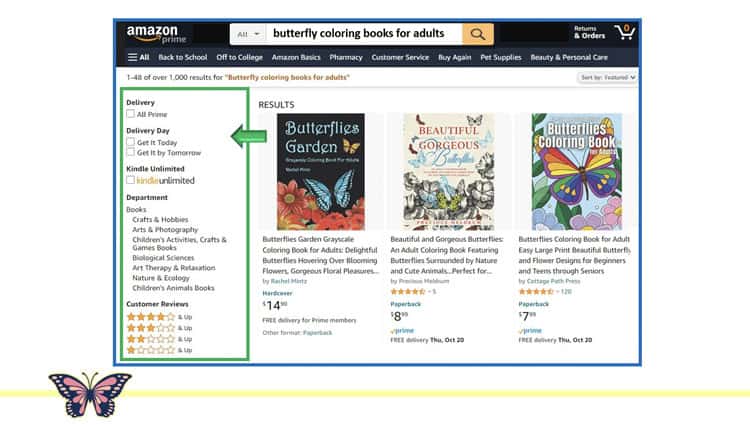
For example, if I were to have an Amazon search query “butterfly coloring books for adults,” Amazon would provide a return that would include 50-plus coloring books. I am not excited about going through pages of returns, and Amazon makes it easy by providing you with search parameters that I can use to help me refine my search. You see the Amazon Search parameters (with a Green outline) to the left of the butterfly coloring books.

When your scroll the page up, you will have the following options
In the Blue outline, you have the following choices
- Delivery: Amazon Prime
- Delivery Day: Get it by Tomorrow
- Kindle Unlimited
- Department: Books/Book Categories
- Customer Reviews: Choose the range of customer ratings you want
In the Green outline, you have the following choices
- Deals: Today’s Deals
- New Releases: Last 30 Days, Last 90 Days
- Craft & Hobby Format: Hardcover, Kindle Edition, Paperback, Patterns
- Author
- Book Language: English, French, Spanish, Italian
In the Red outline, you have the following choices
- Amazon Global Store
- International Shipping
- Condition: New, Used, Collectable
- Availability: Out of Stock [TOC]
Lessons Learned from Coloring Book Purchase
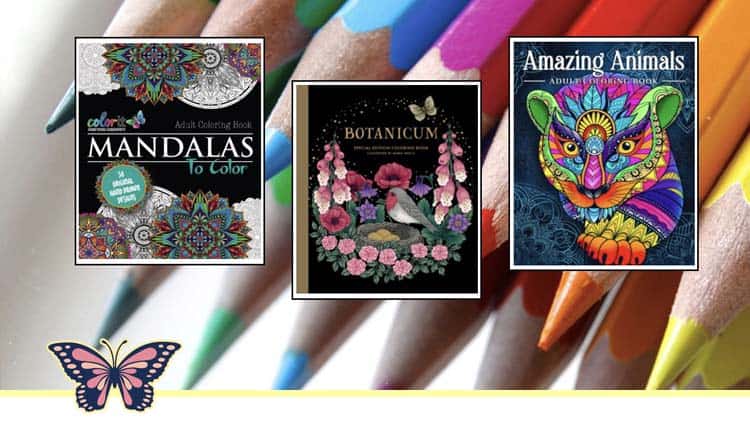
What are the lessons learned when purchasing a coloring book? As I look back on my first 5-10 coloring book purchases, I focused my choices based on the themes and reviews. All the coloring books had pages I liked to color, but I liked some more than others. Often it was the difference in each book’s design and printing, such as paper thickness and quality, binding, printing, 1-sided vs. 2-sided, perforated and more. I made a list of what I liked and why.
As I became more seasoned in my coloring book evaluations, I started reading and studying the coloring book descriptions, specifications, and profiles of the artist. The following are a few of the lessons and considerations I have added to my review of coloring books:
Paper Thickness
Coloring books are printed on 1-side or 2-sides of paper. If you choose a 2-sided page coloring book, choose thicker paper for issues like bleed-through, indentations from heavier coloring pressure, and having printed images show through. [TOC]
Coloring Book Binding
A coloring book can be spiral binding or saddle stitching (stapled spin). Each type of binding will have a bearing on the coloring experience. For example, the spiral bound will allow you to have a flat surface but will significantly add to the cost of the coloring book. The saddle stitch can make it difficult for the coloring book to lay flat but will keep the price of the coloring book lower. [TOC]
Perforated Pages
Perforated pages allow you to remove the pages. With a perforated page, you can remove the page to photocopy the image on paper you like, color it on a flat surface, remove and frame/preserve it, and more. [TOC]
Book Descriptions
Descriptions can give you important clues about whether the coloring book is quality or subpar. A quality coloring book will have written descriptions without poor spelling or grammar. The description will say whether the art is original or hand-drawn, and the number and type of illustrations printed on 1-side or 2-sides. Inadequate descriptions are filled with errors, vague and unrealistic claims and being short on coloring book spec details can be clear signs of a poor/lousy coloring book. [TOC]
Coloring Book Price
Carefully look at the price of the coloring books. For example, I will be presented with various sellers and prices when shopping online (e.g., on Amazon). If you have a popular coloring book from a well-known author/artist (e.g., Millie Marotta, Johanna Bashford) and you find the new sale price to be cheap or from a seller or is overseas (e.g., China), be careful. These books can be fake or unauthorized duplications. The books are usually poor quality (e.g., printing, binding, artwork). I am not going to take the chance. [TOC]
Book Covers (Front and Back)
Book covers can give essential clues to the quality of the coloring book and what’s inside. A quality coloring book will usually have a sharp/professional-looking cover, and there will be no grammar or spelling errors. A quality book’s back cover includes examples of images from the book, a coloring book description, and an ISBN. If the book covers (front and back) are not poorly designed, you probably need to keep looking. [TOC]
Who is the Publisher?
A quality publisher cares about the quality of the coloring book and its features (e.g., paper, cover, descriptions, printing, original art). Some major coloring book publishers are Penguin Random House, ColorIt, and Empire. If the publisher is Kindle/Kindle Unlimited, think twice before you buy because these coloring books are known for being subpar, poor paper for coloring and more. [TOC]
Amazon Inside the Cover Preview
If you are viewing coloring books on Amazon, look for a “Look Inside” feature. This feature will allow you to view a few pieces of artwork in the coloring book, and a quality coloring book will have an inside preview and artwork consistent with the cover theme and description.
If you have a coloring book about dragons and castles, you probably won’t find images of flowers, mandalas, or jungle animals. This inconsistency can be a sign that the works inside are stolen or is a pirated book.
As a member of the coloring community, I want the artist and publisher to be open about what they are providing me. The “Look Inside” feature is essential for the coloring communing to help buyers learn what they can expect from the line art/drawings. Let’s look at two versions of the “Look Inside” preview.
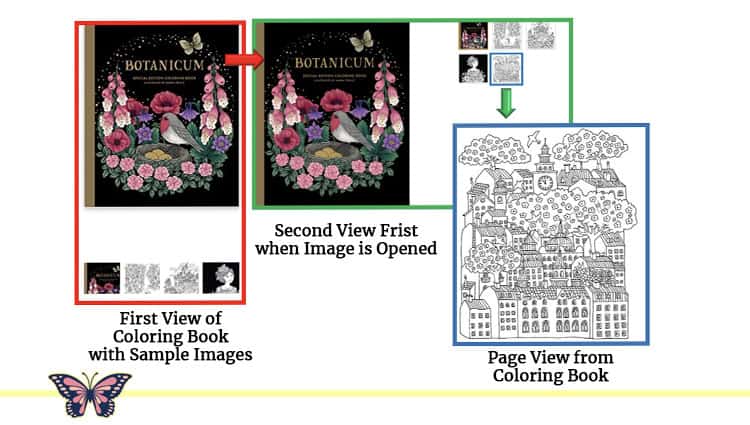
Inside View Example 1 (book image and pages). On the landing page of the coloring books, you have presented the front cover (in Red). When I click on the book, the image opens with sample pages to review (in Green). The image opens by clicking one of the pages so you can see the sample page (in Blue.) This version of the “Look Inside” feature Maria Trolle, “Botanicum.”

Inside View Example 2 (Look Inside with scroll function). On the landing page of the coloring books, you have presented the front cover (in Red) with the words “Look Inside) above the right corner of the book. The image opens when I click on the book, and you are presented with a scrolling window (in Green). The last image (in Blue) is one of the sample pages you see by scrolling up and down. [TOC]
Original Artwork vs. Curated Artwork
When looking for a quality coloring book, I like to see if the artwork is original by the artist/author. Original artwork means that you have a coloring book that is fresh/unique to the author/artist. I stay away from coloring book authors or publishers that assemble clip art, stock images, public-domain artwork (images that are copyright-free) or computer-generated images. Allow me to expand on this decision.
- What’s the concern with a problem with assembled non-original artwork? I have found these books to be randomly put together, with no consistent theme and poor quality.
- Can there be good coloring books with assembled/curated artwork? Yes. Some publishers take great care in assembling free, public domain or stock images and carefully develop themed coloring books. These images are cleaned up and refined to develop a coloring book.
- Why not search and find quality assembled/curated coloring books? Yes, you can do that. You can search for free stock, public domain, sample artist images, and make your coloring book/resource.
- What is the cost difference between original art vs. assembled coloring books? Surprisingly, the price you pay for an original art coloring book is the same or slightly more than the assembled coloring book. I purchased a few better-assembled coloring books and was not pleased with the coloring experience. I am saying spend the same or a little more and get a quality product you can trust and enjoy. [TOC]
Store Shelf Presentation
If you are shopping at a brick-and-mortar store, a quality coloring book can be taken from the shelf to flip through and see what is inside. A poor coloring book will have one or more of the following signs: shrink-wrapped, so you can see inside, be in the discount shelf/bin
Coloring Book Artist/Author Profile
What can I learn about the author/artist telling you about a coloring book? When reviewing coloring books, I make it a habit to learn more about the artist/author. The following can provide clues as to the quality of the coloring book designed by a legitimate author. Look for the
- Artist name and profile. You can tell a lot about the quality of a coloring book by whether the artist has a bio/profile. When reviewing coloring books online (e.g., Amazon), quality book authors will have a bio that includes elements like a bio, follow me, and links to their other books. Subpar coloring books will usually not have author bios because they don’t want their previous work associated with their name, the work they are producing, or a scam bookseller.
- Artists’ social profile. Quality books will have artists with a social media presence on Facebook/Facebook groups and other social platforms. Real artists will promote their books, answer questions, comment, and be community-supportive members. Subpar coloring books will have authors who rarely have a social media presence or interact with the coloring community. The following are a few Facebook groups and directories where the coloring community gathers: [TOC]
If you liked this article, please share it with friends.

